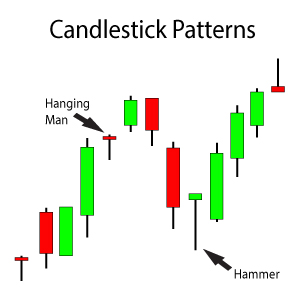Stock Chart Tools
Most trading platforms have dozens of stock chart tools. I've tried to simplify the process by listing the main charting tools that I use here at Trendy Stock Charts. The following narratives provide a quick overview for each tool.
Becoming proficient with stock chart tools involves learning about:
- the components of each stock trading tool
- how to place the tool on a stock's chart or the chart of an index
- what each tool is used for
- some of my personal trading tips
- dangers to watch out for when using the tools
Fibonacci Extension Tool
 The Fibonacci Extension Tool is one of the most versatile tools in my charting toolbox. It is absolutely my favorite charting tool. This tool can be used to calculate a stock's risk to reward ratio (a ratio to determine if a trade is worth entering into or not).
The Fibonacci Extension Tool is one of the most versatile tools in my charting toolbox. It is absolutely my favorite charting tool. This tool can be used to calculate a stock's risk to reward ratio (a ratio to determine if a trade is worth entering into or not).
The Fibonacci Extension Tool can calculate both upside and downside price targets, regardless of the current trend for the stock's share price. These price targets can be used as buy and sell price targets.
I consider this tool a "must-have" for every Trendy Stock Chart member's toolbox.
Fibonacci Fan Tool
 I use the Fibonacci Fan Tool tool to help determine scale-in opportunities on a stock that is trending upwards.
I use the Fibonacci Fan Tool tool to help determine scale-in opportunities on a stock that is trending upwards.
The Fibonacci Fan Tool provides various levels of support that can be used when deciding upon a scale-in strategy. A scale-in strategy is one recommended type of strategy that can be used when purchasing shares of stock.
Fibonacci Retracement Tool
 Fibonacci Retracement Tool - This tool can be used to help determine support levels after a stock's share price appears to have completed its uptrend and has started to pullback. Advanced analysis methods can be used with this tool to also help determine potential upside price targets.
Fibonacci Retracement Tool - This tool can be used to help determine support levels after a stock's share price appears to have completed its uptrend and has started to pullback. Advanced analysis methods can be used with this tool to also help determine potential upside price targets.
A Fibonacci Retracement Tool is usually utilized before using a Fibonacci Extension Tool. Why? The Retracement Tool is usually trying to calculate the pullback area needed for the Fibonacci Extension Tool's Anchor Point #3.
MACD Histogram
At first glance, the MACD Histogram chart indicator can easily be confused with the volume bars on a stock chart.
Unlike volume bars though, the MACD Histogram assigns negative values to its selling bars. Negative bars on a MACD Histogram represent selling momentum.
The MACD Histogram is typically not a default tool selection on most trading platforms, so you must load the indicator onto the chart you are viewing.
Trading Channel
 When identified early on stock chart, a Trading Channel can lead to very profitable trading opportunities as the stock's share price remains mostly constrained by the boundaries of the Trading Channel.
When identified early on stock chart, a Trading Channel can lead to very profitable trading opportunities as the stock's share price remains mostly constrained by the boundaries of the Trading Channel.
Trading Channels are tools designed to give an investor a trading range for the stock's share price, both in uptrends and downtrends.
Trendline Tool
 Trendline Tools are excellent tools to confirm support and resistance areas identified by the Fibonacci Tools I have listed above.
Trendline Tools are excellent tools to confirm support and resistance areas identified by the Fibonacci Tools I have listed above.
Trendlines are one of the easiest yet most powerful tools that an investor has at their disposal. When you start combining two or more Trendlines, you have a potential base from which to develop Chart Patterns.
Join Trendy Stock Charts
 Do you want to learn how to effectively use the above stock chart tools? Then join Trendy Stock Charts today! As a Trendy Stock Charts member, you gain access to the members-only pages on the above charting tools that include detailed information such as:
Do you want to learn how to effectively use the above stock chart tools? Then join Trendy Stock Charts today! As a Trendy Stock Charts member, you gain access to the members-only pages on the above charting tools that include detailed information such as:
- how to place the above stock chart tools on a chart
- tips for consistent success when placing tools on stock charts
- strengths and weaknesses of using different tools
- explanations of the various uses for each tool
- hazards to watch out for when placing the tools on charts
Click the button and start the subscription process to become part of the Trendy Stock Charts team today! Learning how to use various stock chart tools is just one of the handful of benefits of becoming a member. Profiting from their use is another.
Stock Chart Analysis
Can You Identify A Changing Trend?












You must be logged in to post a comment.